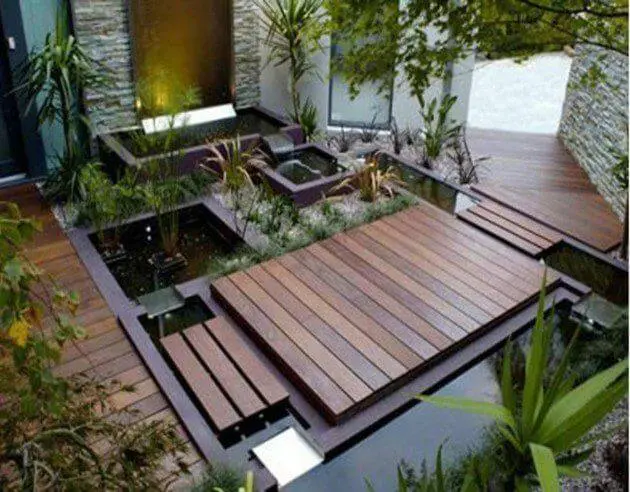Landscapes play a vital role in connecting the spaces with the nature around. Architecturally spaces should be well linked with the nature and it should actually take a form along with the landscape rather than forcing landscape into the left out pockets.
The blend between the hardscapes, soft-scapes and the built forms actually help to enhance the quality of a space and make it more likely to be a boon rather than a burden on the nature or the external environment.
Similarly, landscapes should not be limited up to the structure or the plinth level. Extension of landscape into the interiors make the structure porous with green scapes acting like the necessary catalysts to achieve the supreme connection with the nature and external environment.

Why Indoor Landscaping?
Indoor landscapes mainly focus on bringing along the natural and raw look of the nature to the doorstep of every space making it more lively and natural.
These actually help to maintain the micro climate of the interiors making it efficiently cooler or warmer as required and reducing the strain on the environment by reducing the use of artificial gadgets.
No matter it costs a space but it will prevent the structure to cost for the degrading environment around. Such spaces also help in creating a natural ambience along the various transition of spaces.
Design and Types of Indoor Landscaping
1. Green Garden
- These are generally full lush green plantations or flowers planted in a space where there is ample of light and ventilation.
- They are planned out in courtyards of bungalows, or may be any interior space with proper source of lights and are also planned according to the wind circulation.
- Hence, these help to keep the indoor environment fresh and energetic along with the cool fresh ambience and experience like a walk in a green garden.
- A feel of garden through the transition spaces of your bungalow is what lacks in solid hardscapes making the interiors too rigid and structural.
- This type of landscape is advisable in bungalows or spaces that have clean surroundings around to avoid mosquitoes and insects and also a bit of high maintenance is required.

2. stone Scaping
- The stone landscaping or the stone gardens are an important part of Japanese landscapes and used all over the world to create similar ambience spaces.
- Here, the amount of green spaces is less and is mainly covered with various stone tiles or real pebbles.
- Massing is achieved by using various shape forms of stone and by varying the stone sizes placed in this space.
- Stone scapes in interior are created in courtyards of bungalows, entrance lobbies, extended bedrooms, etc. where they can connect easily with the external environment.
- These spaces can be used as meditation zones as well as like a Zen Garden that is a type of Japanese landscape.

3. Holy Scape
- There are many beliefs and rituals where some plants are considered holy and as good luck for the entire house.
- Such holy spaces can also be created as a part of indoor landscape with some water bodies and holy plantations around with some round pebbles creating a perfect holy ambience.
- Statues can also be installed on pedestals in the center or a particular corner as per the rituals or holy scripts

4. Horticulture
- These are similar to the green garden courtyards. The only difference here is the plantations are well planned and are actually harvested for further use.
- For example, there are some crops like herbs which are planted and also some flowering plants that are used once grown completely.
- This is actually farming on a very micro level. A variety of indoor crops and plants can suffice the need of the end user.

5. Floating Indoor Landscaping
- As the name suggests these are floating landscapes that is some designed landscape patches on some small water body.
- These are not recommended in warm and humid climates as they increase the humidity levels inside the house affecting the interiors.
- The spaces here are generally not accessible and serve as a visual ambience and hence these indoor landscapes can be used in bungalows near the living room area or may be the dining areas where a relaxing soothing ambience is necessary.

6. Water Scapes
- Water scapes are generally used to create a feeling of motion in the interiors.
- There are generally small channels of water or a pond like depression created which is either decorated with a fountain or may be kept still with small pebbles in it giving it a lively feel.
- Water plants or may be other suitable plantations are also added to enhance the beauty of the space giving it a richer and livelier ambience.
- Water scapes can be extended vertically on walls in form of streams rolling down or may be small indoor waterfalls that connect with the ponds or the streams below.
- These are also located near the living areas or may be the dining zones. The streams can also run along the passages or lobbies making the spaces look livelier.

Need and use of Indoor Landscaping
As a result these indoor landscapes play a vital role in increasing the architectural beauty of a space and also makes the space more functional and environment friendly. They provide a variety of rich ambience in an interior space enhancing the value of the entire structure. These are a must in all scales of bungalows as they provide a fresh environment within the spaces connecting them well with the exterior on site landscapes.
– Kushal Mehta





